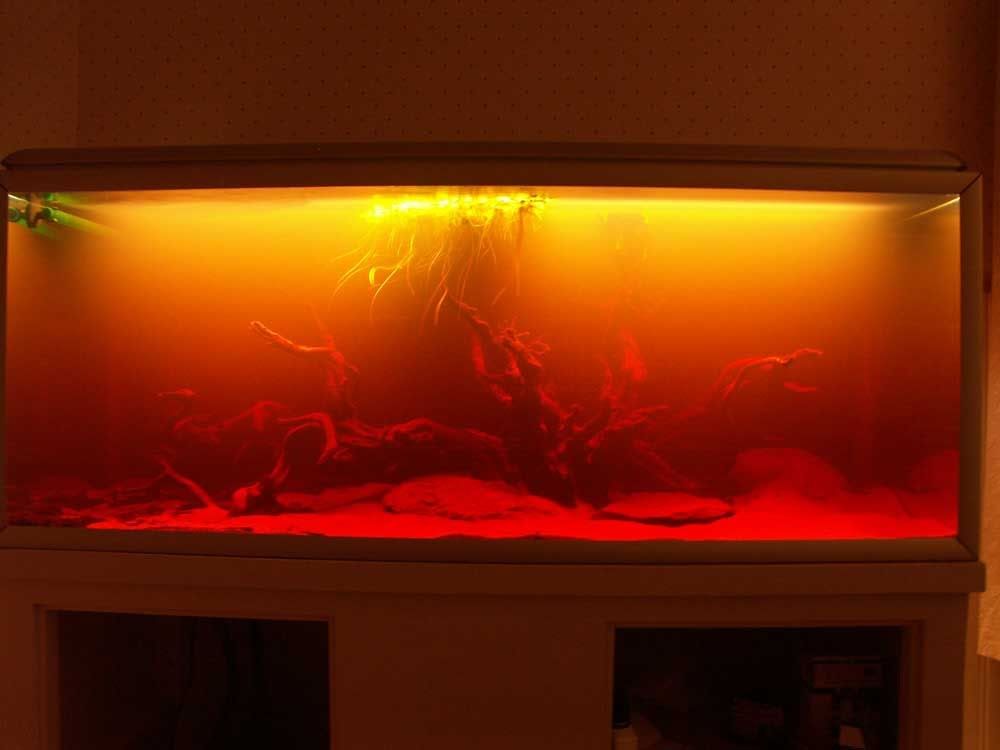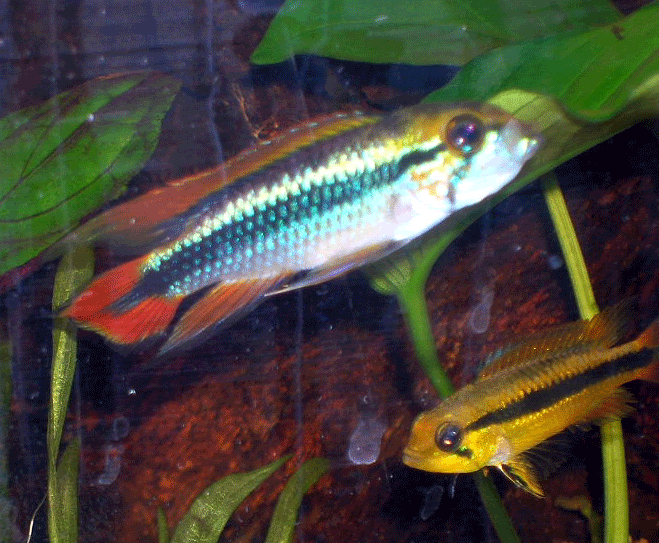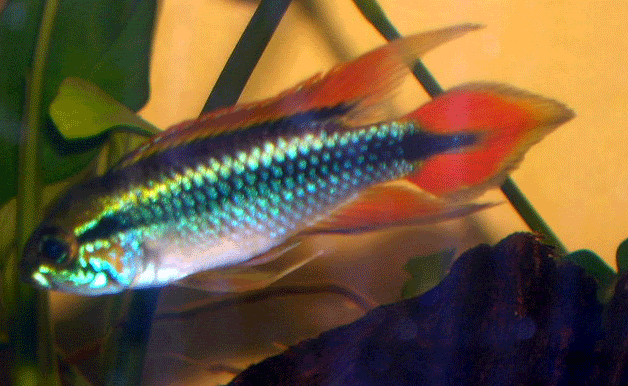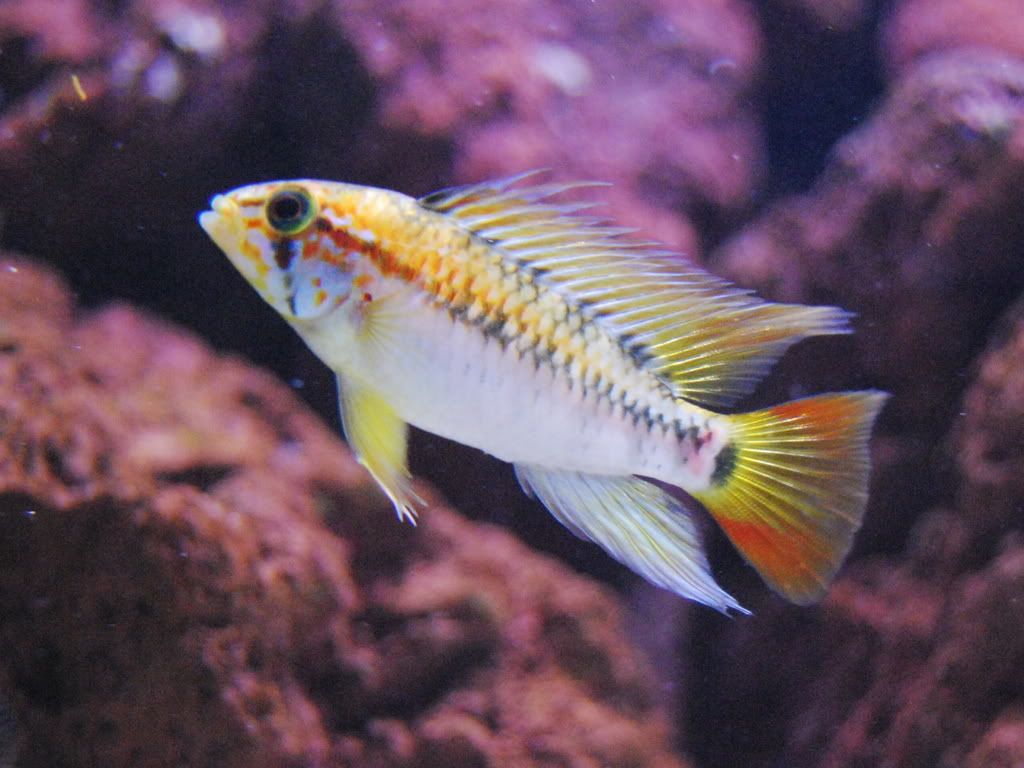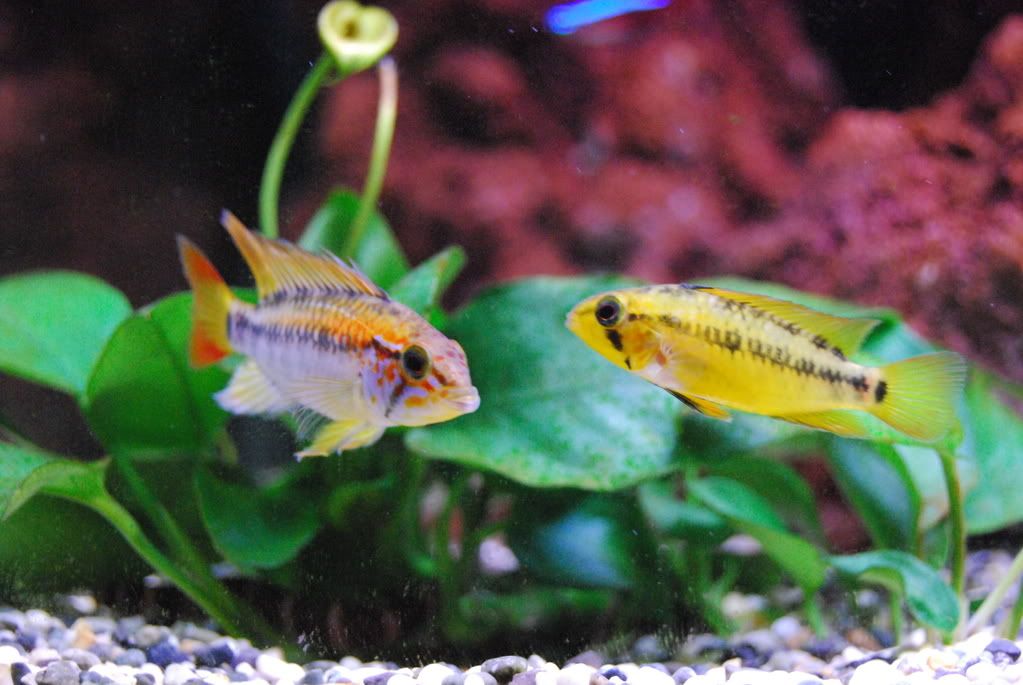För bra länge sedan försöket jag reda ut vilken art som visas i Jörg Vierkes på sidan 31, i mitt tycke en extremt snygg apisto i färg och framför allt form. Pelle kom med en bra förklaring, med nu är jag tveksam igen och tror jag har ett annat svar på frågan. Faktum är att ett av A. bitaeniatas tydligaste och i artbeskrivningen väl definierade kännetäcken är just tvär sträcken i stjärtfenan. Vierkes "Röd kleei" har inte dessa och har enligt mig inte bitaeniatans form. Mitt förslag är A. personata. Se sidan 679 i Mergus "Cichlid Atlas I". Alla fenstrålar förlängda, duvudets/nosens kompakta form stjärtfenans form och mönstersamt fläcken på stjärtspolen. För mig råder ingen tvekan; samma fisk! DATZ A171/172 sid 78 visar en A. (cf) personata, tyvärr en inte helt bra bild. Vad tror du Pelle?
Mvh
Winnie
Tyvärr så har jag inte boken/ katalogen från DATZ. Så jag får relatera till Cichlidenatlas 1.
Eftersom jag praktiskt taget inte vet något alls om Personata,så har jag också gått igenom några diskussions trådar på "apistogramma.com" och hittat en del som rör Cichlidenatlas 1
Enligt Mike Wise så har Uwe Römer felidentifierat fisken som omnämns som Personata. Han menar att bilderna helt enkelt är på en gammal Gibbiceps hane. Och det är mycket möjligt att det faktiskt är så.
Däremot menar han att bilderna på Apistogramma Brevis, faktiskt är Personata! (förvirringen är total alltså!)
Tyvärr finns det ju en hel del felidentifieringar i boken.
Jo jag är också frågande till den där bilden i Jörg Vierkes bok. Det är definitivt inte en solklar Bitaeniata, och det är inte en Gibbiceps heller. Kanske det är en Personata eller Brevis? Vet inte det finns så många andra alternativ?
Jag såg också att Mike Wise hävdar att bilderna på Juruensis faktiskt är sp.Blackchin!
Stämmer det med dina efterforskningar och om du jämför dina fiskar med bilderna i Cichlidenatlas 1?
Här är några av Mikes rättelser till Cichliden atlas 1. Kan vara bra att hålla i minnet när man bläddrar bland arterna i boken:
(Jag har en lista på mer rättelser liggande någonstans på hårddisken, men kan inte hitta den nu :()
"1. A. brevis does not have extended dorsal fin lappets. The fish listed as brevis in Uwe's book appears to be very close to or identical with A. personata.
2. A. juruensis does not have the expansive black chin patch (p. 512, 513 top & 521) nor the narrow abdominal stripes seen on Uwe's fish. A. juruensis has a longer face (distance between eye & snout) & smaller lips that Uwe's fish. We now know that the fish pictured in the Atlas are found in the Rio Nanay, a tributary of the Peruvian Amazon. A. juruensis is found only in the upper Rio Juruá, a tributary of the Brazilian Amazon. Hundreds, if not thousands of water miles separate the two drainages. Before the source of Uwe's fish was ascertained, I also mistook this species (A. sp. Schawrzkinn/Black-chin) with A. juruensis, but I now know I made a mistake. I will agree that they are closely related, like A. cacatuoides & A. luelingi, but they certainly are not the same species.
3. A. maciliensis. After seeing photos of fish that Jeff Cardwell brought back from lakes in the middle Guaporé - like the collecting localities of both A. trifasciata maciliensis & A. t. haraldschultzi - I now belive that there is no separate species "A. maciliensis". Cardwell's fish look just like A. trifasciata except they show no diagonal third band when live. They appear to be just a lake dwelling race of A. trifasciata. We might call them A. trifasciata maciliensis, but ichthyologists are trying to shy away subspecies names right now. The fish Uwe lists as "A. maciliensis" is an undescribed species most commonly called A. sp. Mamoré.
4. A. personata. Compare the fish Uwe calls A. personata with the type specimen (p. 678). Uwe's fish are more elongate, have a shorter face, a broader continuous lateral band (missing scales make it look like it has a separate spot), no rows of spots in the central part of the tail fin, nor rows of spots in the soft parts of the dorsal & anal fins &, much shorter ventral fins (although not visible on Uwe's photo of the holotype of A. personata). Maybe I'm seeing things, but the upper jaw seems to have a small pale blue patch in the corner of the jaw - a feature found in species related to A. agassizii. I believe Uwe's fish are very very old A. gibbiceps.
5. Even Uwe must admit that the fish he pictures as A. pulchra is nothing like the real A. pulchra. Uwe's fish show a prominent caudal spot, something the true A. pulchra does not have. The tail is squared off with 2 or even 3 caudal extensions instead of being round. The real A. pulchra is related to A. agassizii & has the blue patch at the corner of the jaw. Uwe's fish are not that closely related to A. agassizii & do not have the jaw patch. In actuality, Uwe's fish is an undescribed species first pictured by Kullander in his description of A. hippolytae. It later was imported into North America as "A. sp. Lyretail Purus", into Japan as A. sp. Rondonia, & into Germany as A. sp. Erdfresser/Earth-eater.
6. A. sp. Rio Acre (now A. acrensis). Compare the photos on p. 883. The lower fish has black scale edges on the 2nd and 3rd rows below the lateral band. The upper fish has these dark scale edges on the 1st & 2nd scale edges below the lateral band. Staeck, who collected both fish, acknowledger that the upper fish is A. urteagai & the bottom fish is A. acrensis. The upper fish on p. 886 is also A. urteagai. The fish on p. 887 are not even that closely related to the two fish named above. The bright area between the end of the lateral band and the caudal spot is indicative of members closely related to A. regani. It probably is A. sp. Gelbwangen/Yellow-cheeks.
7. A. sp. Smaragd/Emerald displays all of the diagnostic features of the holotype of A. geisleri. Other than the lovely emerald green color, there is no difference in the 2 forms. Smaragd/Emerald very probably is a geographic color morph of A. geisleri, not a separate species.
There are several more misidentifications in my opinion, although not easily explained without going into a long description (this is already too long).
I have always wondered why some of the more obivous error were published. Could it be that the publisher demanded pictures of every described species - even if the IDs had to be "stretched" a little? Hopefully Uwe will correct his errors in his new volume."
För långt inlägg! Jag vet, men jag kunde inte låta bli! :)






